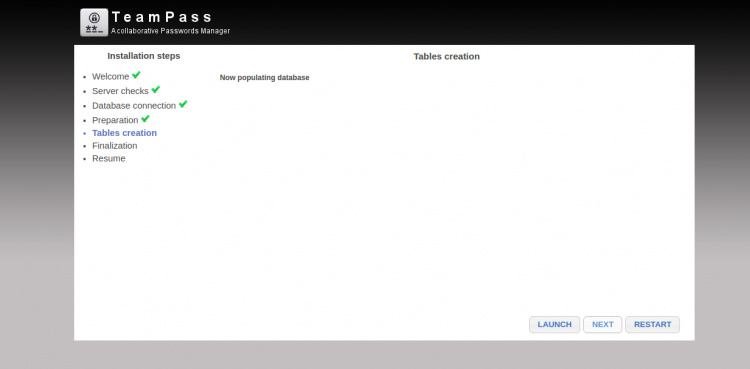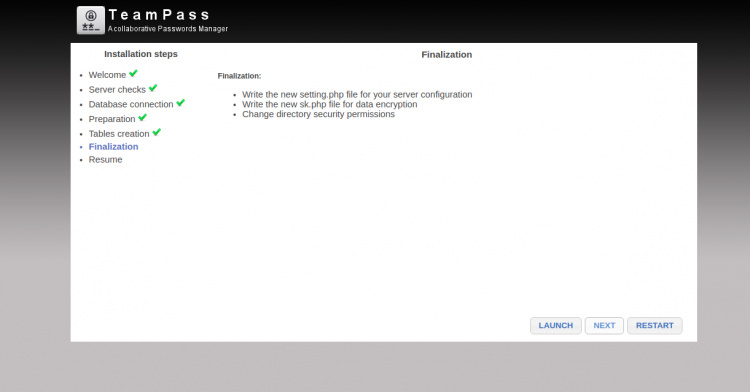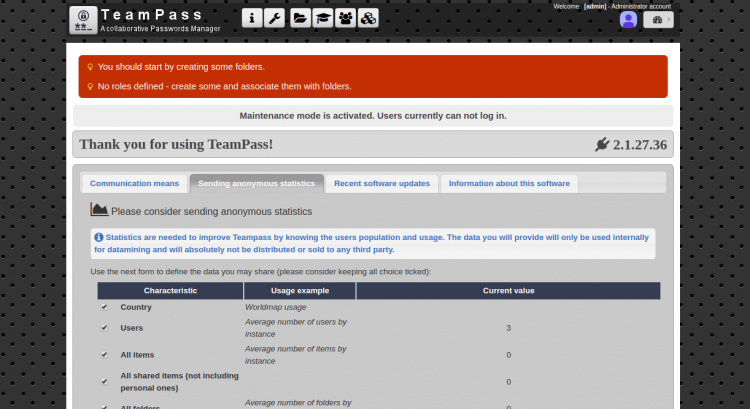Cómo instalar TeamPass Password Manager en Ubuntu 20.04
TeamPass es un gestor de contraseñas colaborativo que sirve para gestionar contraseñas y compartirlas entre los miembros de un equipo. Utiliza la base de datos MySQL/MariaDB para almacenar contraseñas de forma segura. Proporciona una potente herramienta para personalizar el acceso a las contraseñas en función de los roles de los usuarios. Es un software gratuito y de código abierto y te permite gestionar tus contraseñas y datos relacionados de forma organizada con respecto a los derechos de acceso definidos para cada usuario. Viene con un amplio conjunto de funciones, como encriptación de datos, carpeta personal, estructura de árbol, privilegios de usuario, definición de roles y muchas más.
En este tutorial, vamos a mostrarte cómo instalar el software TeamPass Password Manager en Ubuntu 20.04 con Let’s Encrypt SSL.
Requisitos previos
- Un servidor que ejecute Ubuntu 20.04.
- Un nombre de dominio válido apuntado con la IP de tu servidor.
- Una contraseña de root está configurada en el servidor.
Instalar el servidor LAMP
Antes de empezar, asegúrate de que el servidor LAMP debe estar instalado en tu servidor. Si no está instalado, puedes instalarlo con otro paquete ejecutando el siguiente comando:
apt-get install apache2 mariadb-server php7.4 php7.4-cli libapache2-mod-php7.4 php7.4-mysql php7.4-curl php7.4-mbstring php7.4-bcmath php7.4-common php7.4-gd php7.4-xml git wget -y
Una vez instalado el servidor LAMP, edita el archivo php.ini y cambia algunos ajustes:
nano /etc/php/7.4/apache2/php.ini
Modifica las siguientes líneas:
memory_limit = 256M upload_max_filesize = 100M max_execution_time = 360 date.timezone = Asia/Kolkata
Una vez que hayas terminado, puedes continuar con el siguiente paso.
Crear la base de datos TeamPass
A continuación, tendrás que crear una base de datos y un usuario para TeamPass. En primer lugar, inicia sesión en el intérprete de comandos MariaDB con el siguiente comando:
mysql -u root
Una vez iniciada la sesión, crea una base de datos y un usuario para TeamPass con el siguiente comando:
MariaDB [(none)]> create database teampass; MariaDB [(none)]> grant all privileges on teampass.* to teampass@localhost identified by "password";
A continuación, vacía los privilegios y sal de MariaDB con el siguiente comando:
MariaDB [(none)]> flush privileges; MariaDB [(none)]> exit;
Una vez creada la base de datos, puedes pasar al siguiente paso.
Descargar TeamPass
En primer lugar, tendrás que descargar la última versión de TeamPass del repositorio Git. Puedes descargarla al directorio raíz web de Apache con el siguiente comando:
cd /var/www/html git clone https://github.com/nilsteampassnet/TeamPass.git
Una vez finalizada la descarga, cambia la propiedad al usuario www-data y establece los permisos adecuados con el siguiente comando:
chown -R www-data.www-data /var/www/html/TeamPass/ chmod -R 775 /var/www/html/TeamPass/
Cuando hayas terminado, puedes pasar al siguiente paso.
Configurar el servidor web Apache
En primer lugar, crea un archivo de configuración de host virtual Apache para TeamPass con el siguiente comando:
nano /etc/apache2/sites-available/teampass.conf
Añade las siguientes líneas:
<VirtualHost *:80>
ServerAdmin [email protected]
DocumentRoot /var/www/html/TeamPass
ServerName teampass.linuxbuz.com
<Directory /var/www/html/TeamPass>
Options FollowSymlinks
AllowOverride All
Require all granted
</Directory>
ErrorLog ${APACHE_LOG_DIR}/teampass_error.log
CustomLog ${APACHE_LOG_DIR}/teampass_access.log combined
</VirtualHost>
Guarda el archivo cuando hayas terminado. A continuación, habilita el archivo de host virtual apache y reinicia el servicio apache para aplicar los cambios:
a2ensite teampass systemctl restart apache2
Una vez configurado tu servidor web Apache, puedes pasar al siguiente paso.
Proteger TeamPass con Let’s Encrypt SSL
En primer lugar, tendrás que instalar el cliente Let’s Encrypt de Certbot en tu servidor. Se utiliza para instalar y gestionar el certificado SSL Let’s Encrypt para tu dominio. Ejecuta el siguiente comando para instalar el Certbot
apt-get install python3-certbot-apache -y
Una vez instalado el Certbot, ejecuta el siguiente comando para descargar e instalar el Let’s Encrypt SSL para tu sitio web:
certbot --apache -d teampass.linuxbuz.com
Tendrás que proporcionar tu dirección de correo electrónico válida y aceptar las condiciones del servicio, como se muestra a continuación:
Saving debug log to /var/log/letsencrypt/letsencrypt.log Plugins selected: Authenticator apache, Installer apache Enter email address (used for urgent renewal and security notices) (Enter 'c' to cancel): [email protected] - - - - - - - - - - - - - - - - - - - - - - - - - - - - - - - - - - - - - - - - Please read the Terms of Service at https://letsencrypt.org/documents/LE-SA-v1.2-November-15-2017.pdf. You must agree in order to register with the ACME server at https://acme-v02.api.letsencrypt.org/directory - - - - - - - - - - - - - - - - - - - - - - - - - - - - - - - - - - - - - - - - (A)gree/(C)ancel: A - - - - - - - - - - - - - - - - - - - - - - - - - - - - - - - - - - - - - - - - Would you be willing to share your email address with the Electronic Frontier Foundation, a founding partner of the Let's Encrypt project and the non-profit organization that develops Certbot? We'd like to send you email about our work encrypting the web, EFF news, campaigns, and ways to support digital freedom. - - - - - - - - - - - - - - - - - - - - - - - - - - - - - - - - - - - - - - - - (Y)es/(N)o: Y Obtaining a new certificate Performing the following challenges: http-01 challenge for teampass.linuxbuz.com Enabled Apache rewrite module Waiting for verification... Cleaning up challenges Created an SSL vhost at /etc/apache2/sites-available/teampass-le-ssl.conf Enabled Apache socache_shmcb module Enabled Apache ssl module Deploying Certificate to VirtualHost /etc/apache2/sites-available/teampass-le-ssl.conf Enabling available site: /etc/apache2/sites-available/teampass-le-ssl.conf
A continuación, tendrás que seleccionar si quieres redirigir o no el tráfico HTTP a HTTPS, como se muestra a continuación:
Please choose whether or not to redirect HTTP traffic to HTTPS, removing HTTP access. - - - - - - - - - - - - - - - - - - - - - - - - - - - - - - - - - - - - - - - - 1: No redirect - Make no further changes to the webserver configuration. 2: Redirect - Make all requests redirect to secure HTTPS access. Choose this for new sites, or if you're confident your site works on HTTPS. You can undo this change by editing your web server's configuration. - - - - - - - - - - - - - - - - - - - - - - - - - - - - - - - - - - - - - - - - Select the appropriate number [1-2] then [enter] (press 'c' to cancel): 2
Escribe 2 para que todas las peticiones se redirijan al acceso seguro HTTPS y pulsa Intro para instalar el SSL de Let’s Encrypt. Una vez que la instalación haya finalizado correctamente, deberías ver la siguiente salida:
Enabled Apache rewrite module Redirecting vhost in /etc/apache2/sites-enabled/teampass.conf to ssl vhost in /etc/apache2/sites-available/teampass-le-ssl.conf - - - - - - - - - - - - - - - - - - - - - - - - - - - - - - - - - - - - - - - - Congratulations! You have successfully enabled https://teampass.linuxbuz.com You should test your configuration at: https://www.ssllabs.com/ssltest/analyze.html?d=teampass.linuxbuz.com - - - - - - - - - - - - - - - - - - - - - - - - - - - - - - - - - - - - - - - - IMPORTANT NOTES: - Congratulations! Your certificate and chain have been saved at: /etc/letsencrypt/live/teampass.linuxbuz.com/fullchain.pem Your key file has been saved at: /etc/letsencrypt/live/teampass.linuxbuz.com/privkey.pem Your cert will expire on 2020-10-17. To obtain a new or tweaked version of this certificate in the future, simply run certbot again with the "certonly" option. To non-interactively renew *all* of your certificates, run "certbot renew" - Your account credentials have been saved in your Certbot configuration directory at /etc/letsencrypt. You should make a secure backup of this folder now. This configuration directory will also contain certificates and private keys obtained by Certbot so making regular backups of this folder is ideal. - If you like Certbot, please consider supporting our work by: Donating to ISRG / Let's Encrypt: https://letsencrypt.org/donate Donating to EFF: https://eff.org/donate-le
En este punto, tu sitio web está protegido con Let’s Encrypt SSL. Ahora puedes acceder a él de forma segura con el protocolo HTTPS.
Accede a la interfaz web de TeamPass
Ahora, accede a tu interfaz web TeamPass visitando la URL https://teampass.linuxbuz.com. Deberías ver la pantalla de bienvenida de TeamPass:

Haz clic en el botón SIGUIENTE. Deberías ver la pantalla de comprobaciones del servidor:

Pulsa los botones LANZAR y SIGUIENTE. Deberías ver la pantalla de conexión a la Base de Datos:

Proporciona los detalles de tu Base de Datos y pulsa el botón LANZAR y SIGUIENTE. Deberías ver la pantalla de preparación:

Pulsa el botón LANZAR y SIGUIENTE. Deberías ver la pantalla de creación de Tabla:

Pulsa el botón LANZAR y SIGUIENTE. Deberías ver la pantalla de Finalización:

Pulsa el botón LANZAR y SIGUIENTE. Una vez finalizada con éxito la instalación, deberías ver la siguiente pantalla:

Ahora, haz clic en el botón Ir a la página de inicio. Serás redirigido a la pantalla de inicio de sesión de TeamPass como se muestra a continuación:

Introduce tu nombre de usuario como admin y la contraseña que has escrito durante el proceso de instalación, y haz clic en el botón Iniciar sesión. Deberías ver el panel de control de TeamPass en la siguiente pantalla:

En esta guía has aprendido a instalar el gestor de contraseñas TeamPass en Ubuntu 20.04 y a protegerlo con Let’s Encrypt SSL.